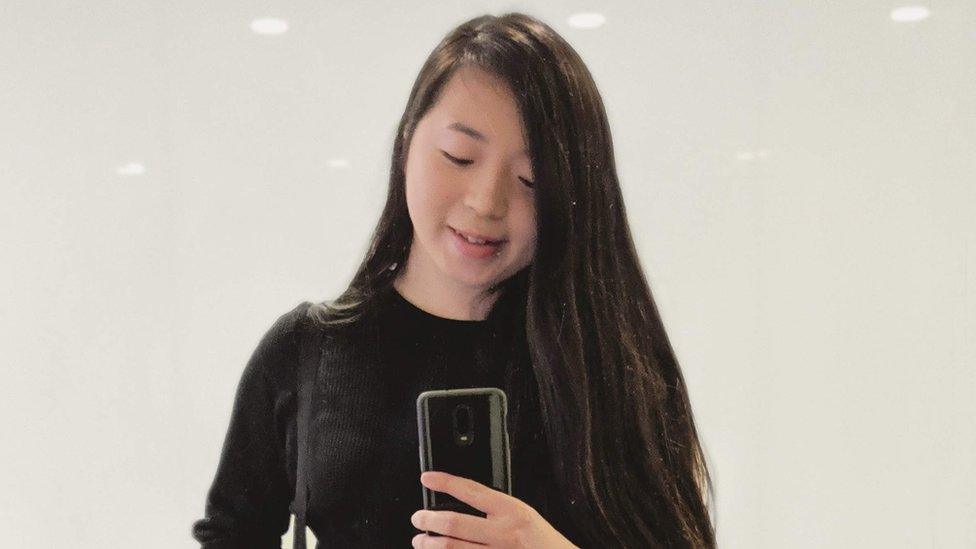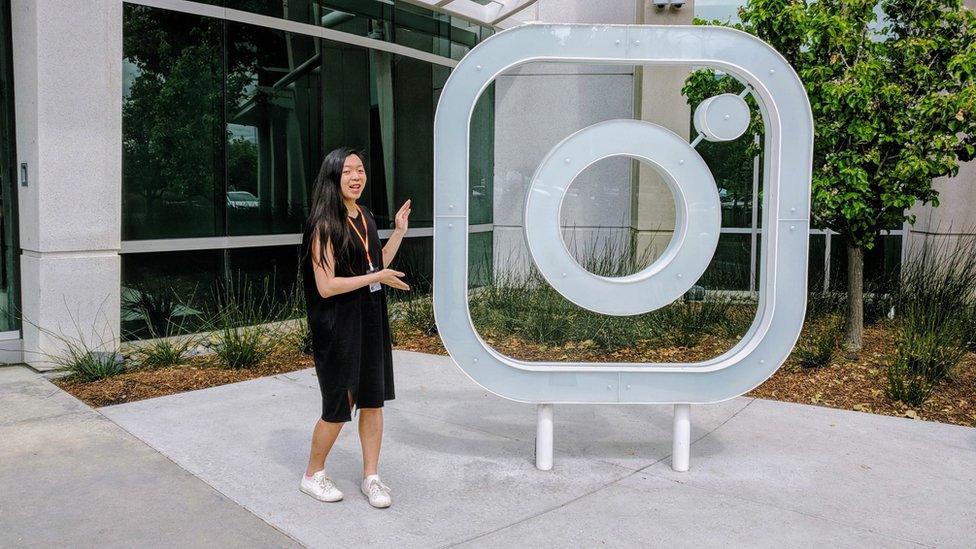Jane Manchun Wong: The woman scooping Silicon Valley
- Published

Jane Wong spends up to 18 hours every weekend combing through code
She was the first person to get a detailed look at Facebook's new dating feature before the designs were released to the public.
She discovered that Airbnb was testing a new flight integration feature that alerted hosts on the website when their guests' planes landed safely.
And she sounded the horn when Instagram began experimenting with augmented reality profile pictures.
Silicon Valley's tech firms like to make a splash when they unveil new features. But half a world away, a Hong Kong-based software engineer has made it her ambition to spoil their scoops.
Jane Manchun Wong, external is a 23-year-old technology blogger and app researcher famous for uncovering new features before they launch.
By reverse-engineering popular apps such as Facebook and Instagram, she is able to preview changes that are still in testing mode. She shares the designs from her Twitter account, which is watched closely by journalists eager for a scoop - and the companies hoping to avoid landing at the centre of one.
'Outburst' on Twitter
Feature-hunting is just a hobby for Ms Wong. She doesn't profit from her scoops, although she has been offered jobs by media organisations eager for her exclusives.
But some of Ms Wong's scoops are so big that they threaten to impact the stock market, leading some to accuse her of insider trading.
When Facebook announced its new dating feature last spring, the Match Group - which owns the dating app Tindr and website Match.com - saw stocks plunge by more than 20%.
And so when Ms Wong tweeted the first public screenshot of Facebook Dating's homepage a few months later, she faced a Twitter storm of comments saying that she was purposefully manipulating the market for her own profit.
"Not everybody understands computing and information security, and sometimes when people see something I post they overreact," she said.
Ms Wong said that the accusations caused her to have an "outburst" on Twitter.
"I felt very angry," she said. "But I don't see a lot of trolling. It's hard for them to find a talking point against me."
A white-hat hacker
Despite being a hacker, Ms Wong tries to stay on the right side of trouble. Even as a young child, her tricks tended to delight more than to aggravate.
She told the South China Morning Post in an interview, external that one of her earliest hacks was to manipulate a software program that calculated typing speed. By changing the underlying JavaScript code, she hacked her way to first place in a school-wide competition.
She credits her father with kick-starting her interest in technology - not because he encouraged programming, but because she taught herself valuable subversion skills while trying to get past the passwords he set on the family computer as a kid.
And, like her dad, the Silicon Valley tech giants are having to up their game to avoid getting hacked by Ms Wong.
"Since I started getting some interest and the companies started monitoring my tweets, more companies have been improving their app security," she told the BBC.
"That is one of my points of doing this... companies will improve their app security so it's harder to break in."
Turning heads in Silicon Valley
Ms Wong can tell her scoops are causing a stir at the tech firms she tends to hack most regularly. After sharing the screenshots of Facebook's Dating homepage, she said the company quickly added some code that prevented her from taking any more photos from her phone.
Allow X content?
This article contains content provided by X. We ask for your permission before anything is loaded, as they may be using cookies and other technologies. You may want to read X’s cookie policy, external and privacy policy, external before accepting. To view this content choose ‘accept and continue’.

Sometimes the features she discovers quickly disappear - which is what happened to a Facebook map she found that showed nearby friends' locations. A Facebook web address that listed all publicly available wi-fi networks in a given location also disappeared quickly after she tweeted about it.
Employees sometimes get in touch with her on Twitter, complimenting a code crack and sometimes offering referrals to work at their tech firms.
And more and more often, companies are guarding their updates until moments before announcing new features. According to Ms Wong, when Instagram announced the launch of their vertical video platform IGTV last summer, they didn't publish the code until half an hour before the announcement.
"I knew that they were going to have a keynote, I kept frustratingly tapping the refresh update, refresh update app," she said.
"Normally when companies test experimental features, they publish the changes to a production version of the app and then [...] turn the feature on for certain users. Then when they launch, they switch the feature flag on for everyone.
"For this feature, they used a different approach - and they indicated it was because of people like me."

Ms Wong scooped Instagram's announcement of its vertical video platform
For the love of apps
Ms Wong says she spends up to 18 hours every weekend combing through code. That's in addition to her paid work as a freelance bug bounty hunter, reporting security flaws to companies before a malicious hacker is able to access their software.
So why does she do it?
Ms Wong says that a lot of her motivation comes from a love of the apps that she uses on a daily basis, and a desire to understand the changes that are on the way.
When an app update is released, the description of the changes on the App Store usually just mention fixes and improvements. "I don't find that particularly transparent," she said. "I want to crowd-source the change-log by myself."
She also told the BBC that reverse-engineering apps helps her learn more about code. She is pursuing a degree in computer science at University of Massachusetts Dartmouth in the US, but is currently taking a break from her studies.
"Once I find a pattern, it will only take five minutes to break the code. But oftentimes in the process I learn something new," she said.
- Published4 April 2019

- Published13 April 2018
